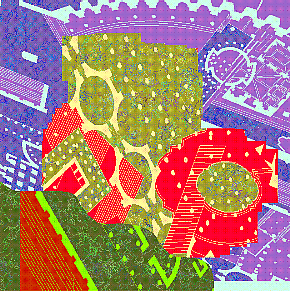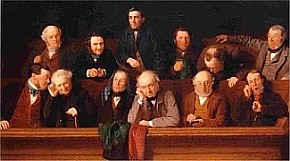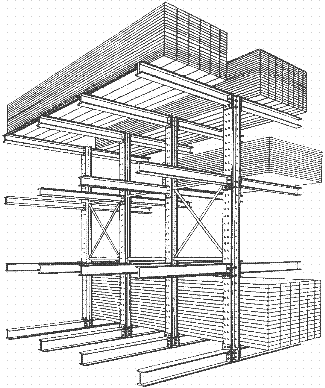2007.03.10 20:42
...and speaking of random tangents
"In the summer of 1800, when the architect was away on his wedding trip, [John] Barber absconded, taking with him a considerable sum of money and all the most valuable office and personal papers."
--Hamlin
And the John Barber Award for Architectural Deviance goes too...
2007.04.23 17:08
Featured Discussion: Volume
Firminy church by Le Corbusier
Hurva synagogue by Kahn
composition 1a : the act or action of composing : the formation of a whole especially by different things being put together
To confuse or not to confuse, that is de-territorialization?
The church/synagogue composition came as a result of seeing how the plan of the church fit almost perfectly within the sanctuary(?) of the synagogue. And, since I had a model of both buildings, I just wanted to see the superimposition in 3D. And upon seeing that I thought, "Gosh, that kinda looks like a mosque." Trust me, de-territorialized thinking isn't necessarily brilliant, although for the most part uninhibited.
Anyway, back to Volume....The reporter on the radio just said, "Heavy volume on Passyunk Aveune..." Hey, traffic would make a great theme for a heavy issue. Trafficking in Architecture--I wanna write about stolen goods.
I think Passyunk is an old 'Indian trail'. Wow, Philadelphia's Indian trails, talk about de-territorialization.
2007.04.25 10:24
Featured Discussion: Volume
"...a 'hard copy' tool that brings in more architectural clients..." -- Was Le Corbusier subliminally advertising? Did the publication of SMLXL coinciding with an exhibit at MoMA bring Koolhaas/OMA more clients? I'll say probably and probably.
(I assume) clients look for someone they can trust, and they probably do that by seeing what architects are already trusted.
But your answer is viable, nonetheless. Just also be aware that the architectural field is repleat with (subliminal) copy-cats.
The client asks:
Are you an architectural brand or are you an architectural knockoff?
The architect responds:
That depends, are you a brand client or are you a knockoff client?
How many clients do you think I'd attract with "hardcopy" entitled Volume and Congestion?
2007.06.25 10:36
For the pleasure of sharing ideas, through the poetry of the printed word
What I'd like to do more of is 'fictitious historical dialogue'.
As of yesterday, reading Duboy (again) along with ongoing Montesquieu and spotty Foucault--bricolage plus letters plus Las Meninas etc. Mix that with 'fictitious historical dialogue' and you have my next book project.
It's a book about all kinds of style. The working title is über œuvred e suicidal. Piranesi hires a Quaker lawyer to fix historical inaccuracies while the Quaker lawyer hires Piranesi to design an historically accurate house. Neither knew of the other's true propensity--playful double-meaning meets good-natured honesty--yet they discover themselves to be a formidable team. You'll think you're laughing and you'll laugh about thinking.
2007.06.26 11:55
For the pleasure of sharing ideas, through the poetry of the printed word
I love being inspired, thus the new working title of my next book project is The Faux Failing Memory.
The interesting thing about the written word is that you can almost always tell when the author isn't being completely honest. At least I can.
2007.07.30 19:16
Necessary architecture books
worth holding your breath for....
Towards a Squeezed-Out Architecture
Heavy Volume Everywhere
The Architect Came Twice (in foreign tongue)
One Size Fits All
2007.07.30 22:20
Necessary architecture books
a must for all clients:
Does Your Architect Wear Boxers or Blobs?
2007.08.04 17:32
Koolhaas & Eisenman Discuss "Urgency" at the CCA
I thought the point was Archaeologies of the Future.
'Opaque' perhaps, but never without clues. The way I see it Koolhaas's architecture becomes him while Eisenman becomes his architecture. [Vanbrugh is at the top of the list if that helps.]
"Pejorativity" is an important chapter in The Irrelevancy Style of Architecture.
My tendencies are more coincidental than anything else.
2007.08.08 12:03
spreading like a virus...(discuss)
[googled "redesigning newness" and received no results]
Redesigning Newness: Architecture's Search for an Answer to Sprawl
| |
2007.10.17 18:18
The Vanity Press
The Journal of Artificial Parameters constantly asks for my work, and I keep telling them I prefer the work remain virtual.
2008.01.15 17:25
The Best of Rita Novel Anytime
The novel I'm reading now is a non-theory Western--Bling, Blang and Blog.
2008.03.19 12:39
Eisenman vs Zumthor theoretical approach
Wow, Kejduh's "The Imagination of Embryonic Development" flies better than time!
Yeah, that and Le Deuzzy's "Shoaling".
2008.04.05 10:32
READING LIST
Page 68 of Privacy and Publicity: Modern Architecture as Mass Media is loaded, and the dyslexical error therein provides a spark capable of igniting an explosion. More truth may in fact lie with the notion that the attributes of memory and remembrance are indeed interchangably fluid rather than strictly opposed. Le Corbusier's 'doctoring' of photography (as discussed in the chapter after page 68) even seems to be a perfect example of the interchangable fluidity of memory and remembrance.
--Balloon and Prick: Modern Reading as Virtual Architecture, (forthcoming).
2008.04.15 18:10
Floor Plans

Institute of Indigestion
You R what U eat Department
2008.05.19 20:47
The Official Paradigm Shift thread
After reading "Shifting Paradigm Part I" and "Shifting Paradigm Part II" (which really didn't impress me), Koolhaas's "Typical Plan" text came to mind. I'll read it again more carefully. I feel there might be some connection to 'generic-ness' and the decorated shed. Maybe not.
some great quotes though:
Typical Plan provides the multiple platforms of 20th-century democracy.
Typical Plan is minimalism for the masses.
Typical Plan knows what European architecture will never learn.
...it is architecture as mantra.
I'm secretly working on Plan Atypical.
2008.05.20 09:45
The Official Paradigm Shift thread
Seven Typical Plans of Ambiguity or Plan Atypical
The first typical plan of ambiguity arises when a detail is effective in several ways at once.
In the second typical plan of ambiguity two or more alternative meanings are fully resolved into one.
The condition for the third typical plan of ambiguity is that two apparently unconnected meanings are given simultaneously.
In the fourth typical plan of ambiguity the alternative meanings combine to make clear a complicated mind in the architect.
The fifth typical plan of ambiguity is a fortunate confusion...
In the sixth typical plan of ambiguity what is designed is contradictory or irrelevant and the user is forced to invent interpretations.
The seventh typical plan of ambiguity is that full of contradiction, marking a division in the architect's mind.
5, 6 and 7 are my favorites.
2008.07.29 08:40
I smell a Vorläufer
Ven Izsent, Architecture Exaggerated (Hypopolis: Universe of Overstate Press, +/- the future).
"It's like architecture as gaseous giant. And Izsent is a prick."
--The New Diminishing Globe
2008.07.31 16:32
It rocked Eisenman on his chair...
It wasn't enough that Maria remained a virgin consort to a 14 year-old Emperor, she then had to witness the only English Pope take her sarcophagus for himself. She's now writing The Plays of Nicholas Breakspear.
2008.08.02 09:22
I smell a Vorläufer
There's no argument as to the existence of architectural precedents, rather that the precedents themselves manifest a nimiety of diversity.
more from Oresko...
"But probably the most important and wide-reaching effect Piranesi had upon his friend was the transmission of his notion of artistic licence. The concept of abstracting the elements of classical culture and then rearranging them into a pattern of one's own was developed and expounded largely by Piranesi. As with Inigo Jones, it is obvious that Robert Adam cast his intellectual net widely and borrowed from a staggeringly rich variety of classical, Renaissance, Baroque and contemporary sources. But, again with Jones, his scholarly tabulation of a seemingly inexhaustible number of architectural details and the concomitant reliance upon earlier modes for inspiration did not result in Adam's being a mere copyist or pasticheur. Elaborating upon Piranesi's doctrine of artistic licence and relying upon what he saw as the authentically classical approvel of the individual artist's genius, Adam blended his elements, what ever their source, into his own personal manner, and the compound which resulted was always pure Adam."
Is Unarrested Architecture written by otherness?
"Rather is it a matter of destabilizing the current assumptions by admitting otherness in a way that disturbs the very concept of architecture and the architect. It is time for expanded architects to publicly explore the enigmas and destabilizing elements of all buildings rather than repress them, allowing the mystery or instability of the built object that attracted them in the first place to come to the surface, and admitting mystery into their own stories."
--Wigley, 2006.
You know, Wigley actually told me it was indeed fate that I was there (in Brussels, 1999), because I had already manifest what was the point of the closing address he was to deliver the next day. I guess he smelled a Vorläufer.
| |
2008.08.07 08:44
I smell a Vorläufer
"The errors that Robert Adam detected in Palladio's drawings for the reconstruction of the 'Baths', published in 1730 as Fabbriche antiche disegate da Andrea Palladio, encouraged a dismissive attitude to Palladio and led him to question the accuracy of the renaissance as a reliable recorder of classical architecture. It became easy for the brothers to delude themselves into thinking that they alone possessed a deep insight into the antique and had the knowledge necessary to correct the errors of renaissance draughtsmen. But such an arrogant stance was more a public one, which did not stand in the way of their serious study of the renaissance or their need to borrow directly from it, from time to time. The enormous variety found there appealed to them as much as the inventive classicism of the antique."
Tait
Just as an aside, Fabbriche antiche disegate da Andrea Palladio was used in the formation of Roma Interrotta Sector VI.
Authorship Architects: A Work in Progress
1. Piranesi
2. Piranesi
3. Piranesi
4. Adam & Adam
5. Durand
6. Durand
7. Seroux d'Agincourt
8. Schinkel
9. Schinkel
Coda: Hejduk
2008.09.03
ideas
1. working title: All Within Hadrian's Limits. A narrative non-fiction story of Piranesi's Ichnographia Campus Martius. The idea is to start writing with all the Hadrian related material: mother/son, Antoninus, Bustum, etc.
2. cut & paste museum: create a model of all the complete models; a "riff" off Gehry's so far unpublished (PMA) design.
3. create a Hejduk House 15 model using the pieces of Wall House 2.
2008.09.05 08:43
MVRDV masterplan in Tirana
It's not geo-mimicry, it's jury-mimicry!

"Hey, let's design a reenactment of this painting."
"Yeah, we'll do it like abstractly, and when other architects see the scheme they'll start reenacting a design jury."
"Brilliant!"
--excerpt from "Scalping Double Theater Tickets" in The Further Adventures of the Broke Baroque Style.
| |
2008.09.05 09:38
MVRDV masterplan in Tirana
the next design...

2008.09.05 09:53
MVRDV masterplan in Tirana
"In September 2001, while seeing a display of quartz crystals (each labeled as to its geographic origin) compiled over 100 years ago, I thought it would be cool if the buildings of any global location started to match the formations of the local quartz. It was after seeing Harz Mountain quartz that the idea crystalized."
2004.10.05 14:54
--excerpt from "Ur-Geo-Mimicry" in Architektur von Vorläufer
2008.09.11 07:50
the concept of surface
or
Tad Hertz, Coming Apart at the Seamless: dissecting architectural superficiality, 2008.09.11.
4706b
2007.09.24
Architecture in Critical Condition
2008.11.07 13:37
New MVRDV high Rise in Copenhagen

School of Intemperate Cantileverage

Home Depot Home Kit?
| |
2009.07.30 08:06
Rant Magazine... "Artist"/Designer? submittals
Exponential Potential Architecture
1. Architecture plus Weaponization
2. Architecture minus Weaponization
3. Architecture times Weaponization
4. Architecture divided by Weaponization
5. Architecture greater than Weaponization
6. Architecture less than Weaponization
7. Architecture to the power of Weaponization
8. the Weaponization root of Architecture
2009.11.20 11:50
The Great Books (of Architecture)
The Decline of the Whiskey Empire
Eutropian Theories
Voodoo Valley, 19120
buildings that move(d)
Apostate Architecture
Kissing That Reality Good-bye
The Last Great Pagan Architecture of Rome
Uninhibited Habitations
Architecture of the Divided States of America
Appositional Architecture
Rita Novel This Sontag
2011.01.24 21:18
what is our current architectural style called
Architecture style is no longer defined by space, rather by time.
"Their house is the epitome of 2002 style."
"Design me something early 1840s. I'm feeling immediate-post-Schinkel lately."
"In the year 2525, when architecture is finally alive..."
2012.05.06 18:08
Help with Thesis: Memory and Urbanism
Sounds like you're headed toward Random Access Memory and Urbanism.
2012.06.12 14:36
Why is architectural theory so hard to read?
For lots of reviews of The Possibility of Absolute Architecture google search aureli “absolute architecture”. There’s even a link to an almost 2 hour video of Aureli speaking on the subject, and google/books offers a substantial preview of the book.
Lotus International 19 happens to be the first Lotus magazine I ever bought, so its contents are (still) fairly well ingrained within my memory. Looking over "Cities within the city" (again) last night reminded me of another subsequent Ungers essay--"Architecture of the Collective Memory"--also published within Lotus, this time Lotus International 24 (1979). I personally remember this essay as something I really connected with, something that I really liked the idea of, but I don't think I've (re)read the essay in many years. Of course, I reread "Architecture of the Collective Memory--The infinite catalogue of urban forms" last night, and wow, it like blew me away because what Ungers relates is exactly how I've come to see Piranesi's Ichnographia Campus Martius, that is, as a whole city of architecture of collective memory, indeed an infinite catalogue of urban forms (e.g. 3123h, 3123i, 3123j, 3123k). Interestingly, such a view of the Ichnographia Campus Martius is what Aureli (and Eisenman) do not (want [you] to) see the Ichnographia Campus Martius as.
Being restless, I continued to read more of The Possibility of Absolute Architecture. I read the Boullèe chapter and stated the Ungers/OMA chapter (five). Ten pages into chapter five you encounter material on the Havellandshaft, which is how Ungers ends "Architecture of the Collective Memory," yet Aureli nowhere mentions the "collective memory" aspect of the Havellandshaft (nor does Aureli footnote reference "Architecture of the Collective Memory--The infinite catalogue of urban forms" in Lotus International 24).
I now feel inspired to write a book entitled The Reality of Convenient Memory Architecture, theory even.
"Architecture of the Collective Memory" begins with these passages:
In his book Invisible Cities Italo Calvino invented an imaginary conversation between the Venetian traveler Marco Polo and the great emperor of a distant country. "At this point Kublai Khan interrupted him or imagined interrupting him, or Marco Polo imagined himself interrupted, with a question such as: 'You advance always with your head turned back?' or 'Is what you see always behind you?' or rather 'Does your journey take place only in the past?'"
All this so that Marco Polo could explain or imagine explaining or succeed finally in explaining to himself that what he sought was always something lying ahead, and even if it was a matter of the past it was a past that changed gradually as he advanced on his journey, because the traveler's past changes according to the route he has followed: not the immediate past, that is, to which each day that goes by adds a day, but the more remote past. Arriving at each new city, the traveler finds again a past of his that he did not know he had: the foreigness of what you no longer are or no longer possess lies in wait for you in foreign unpossessed places.
2012.12.30 13:05
In the future, everything will be a museum.
I believe in multiple choice:
a. Welcome to the Hotel Zeitgeist.
b. In the future, everything will be a Zeitgeist Museum.
c. In the futute, everything will be a museum shop.
d. One museum fits all Zeitgeists. (Period rooms of the world unite!)
e. In the Zeitgeist, everything will be the future.
2013.02.14 11:22
14 February
Log 26 came in the mail two days ago; I read Scolari's "Representation" early this morning. In a somewhat typical way, he says some judgmentally naive things about CAD drawing like, "A computer delocalizes our memory because the entire information library doesn't belong to us, because it's not inside us; it has little to do with our feelings and our mind--that is with our memory." The name of every CAD drawing file I create is simply the date it was created, thus each of my drawings is a very precise, well stored memory easily shifted into random access memory.
Scolari does say, however, some nice things about drawing/not drawing Calvino's Invisible Cities. It got me thinking that what I've been doing for more than half of the last 30 years is drawing/not drawing an invisible museum of architecture.
2013.04.27 16:38
Why has the house lost its power?
Perhaps "no professor will ever bring up a house published on dezeen.com" because that will undermine the hyperbolic cost of architectural education.
My mind just started to wander because I'm now imagining a bitingly ironic book entitled You Get What You Pay For.
2013.07.18 13:13
18 July
...some Borges, some Capote, some Quondam
"A labyrinth of symbols," he corrected. "An invisible labyrinth of time."
"...I questioned myself about the ways in which a book can be infinite. I could think of nothing other than a cyclic volume, a circular one. A book whose last page was identical with the first, a book which had the possibility of continuing indefinitely."
I have taken on the mysterious duty of reconstructing literally his spontaneous work. My solitary game is governed by two polar laws. The first permits me to essay variations of a formal or psychological type; the second obliges me to scarifice these variations to the "original" text and reason out this annihilation in an irrefutable manner...
Some years earlier, Lillian Ross had published Picture, her account of the making of a movie, The Red Badge of Courage; with its fast cuts, its flash forward and back it was itself like a movie, and as I read it I wondered what would happen if the author let go of her hard linear straight-reporting discipline and handled her material as if it were fictional--would the book gain or lose?
...I wonder what would happen if the architect let go of his straight-curating discipline and handled the material as if it were fictional--would the museum gain or lose?
|